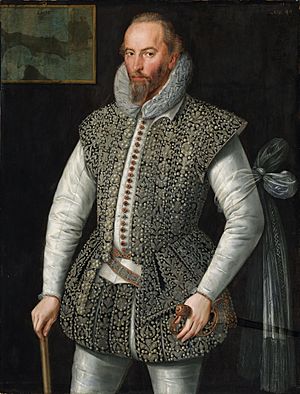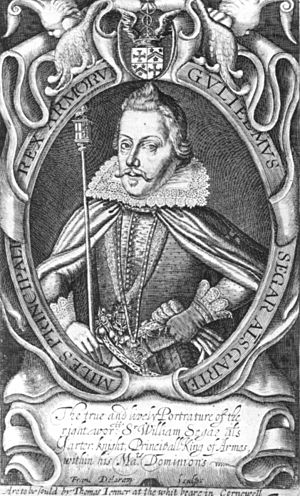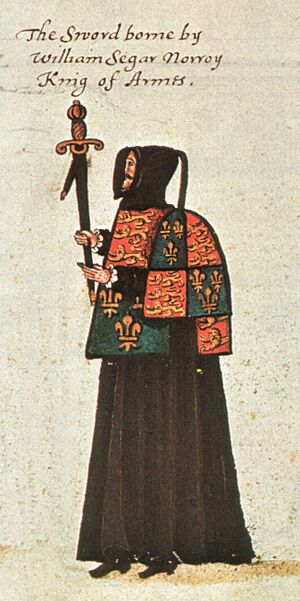William Segar facts for kids
Sir William Segar (born around 1554, died 1633) was a talented portrait painter. He was also an important official who worked for the royal courts of Queen Elizabeth I and King James I. He became the top officer of arms, known as the Garter King of Arms.
Like other artists from the Tudor period, Segar was good at more than one thing. He painted portraits of important people at court. He also worked at the College of Arms, which is like a special office for coats of arms and family histories. He painted Queen Elizabeth's favorite, the Earl of Essex, wearing his black armor for a special event in 1590. Some people think Segar also painted the famous "Ermine Portrait" of Queen Elizabeth.
Contents
About William Segar's Life
William Segar was likely born in England. We know he was about 50 years old in 1604. He married Helen Somers and they had six children. Later, he married Maria Browne and they had seven children, including his son Thomas who also became an officer of arms.
In 1616, a rival named Ralph Brooke, who was another officer of arms, tried to trick Segar. Brooke made a common hangman pretend to be a gentleman. Segar, not knowing the truth, confirmed a foreign royal coat of arms for him. Brooke then told King James I, and both Brooke and Segar were put in prison for a few days. They were soon released, and the King hoped Segar would be more careful in the future.
William Segar's Work with Coats of Arms
Segar first trained as a scrivener, which means he was skilled at writing documents. He got a job working for Sir Thomas Heneage, a high-ranking official for Queen Elizabeth. Thanks to Heneage, Segar joined the College of Arms in 1585.
While working as a junior officer called a Portcullis Pursuivant, he went with Robert Dudley, Earl of Leicester, on a trip to the Netherlands in 1586. Segar helped organize a big celebration there. He later wrote a detailed description of this event.
Segar was promoted to Somerset Herald in 1589. Then, in 1593, he became Norroy King of Arms. As Norroy, he carried the Sword of state in Queen Elizabeth I's funeral procession in 1603. A drawing from that time shows Segar wearing his special black robe and his herald's colorful tabard (a special coat with a coat of arms on it).
In 1596, Segar traveled with the Earl of Shrewsbury to France. There, he helped to give the Order of the Garter (a very important award) to Henry IV of France.

In 1604, Segar was chosen to be the Garter King of Arms, the highest position in the College of Arms. He was officially confirmed in this role in 1607. In 1612, he gave the Order of the Garter to Maurice, Prince of Orange. Segar was knighted by the King in 1616, becoming "Sir William Segar."
Segar also wrote books about honor and coats of arms. His first book was published in 1590. An updated version with pictures came out in 1602.
William Segar as a Court Painter
William Segar was known as a skilled painter. He painted a special picture for St. Paul's School in 1585. The famous "Ermine Portrait" of Queen Elizabeth I is also from around this time and is sometimes thought to be his work.
In the early 1590s, the Earl of Essex often hired Segar to paint. Segar also painted portraits of other important people at court, like the Earl of Leicester and Sir Francis Drake. The last time he was paid for a painting of the queen was in 1597.
Jane Segar, William's Sister
William Segar had a sister named Jane Segar, who was also an artist. In 1589, Jane Segar created a special book of poems called The Prophecies of the Ten Sibills upon the Birth of Christ. She made beautiful covers for her book using a special glass decorating technique.
Jane likely made this book as a gift for Queen Elizabeth I, hoping to get royal support and more art jobs. Not much else is known about her work. William Segar wrote that his sister married a man named Lionel Plumtree and was in Russia in 1603.
Portraits by William Segar
Segar's Family Coat of Arms
 |
|
See also








